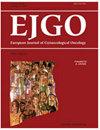Hyperthermic Intraperitoneal Chemotherapy (HIPEC) in the Management of Advanced Ovarian Cancer. A Literature Review
IF 0.5
4区 医学
Q4 OBSTETRICS & GYNECOLOGY
引用次数: 0
Abstract
The rationale behind the use of hyperthermic intraperitoneal chemotherapy (HIPEC) after cytoreductive surgery is the association between pharmacological activity of chemotherapy delivered to the peritoneal cavity with the enhanced cytotoxic effect of hyperthermia. Data on the efficacy of HIPEC in the primary debulking surgery (PDS) setting are still controversial and limited by the small sample size of most of the studies, the inclusion of different treatment settings and chemotherapy regimens. Among the ongoing prospective trials, only the OVHIPEC-2 trial is investigating exclusively patients submitted to PDS ± HIPEC with cisplatin 100 mg/m 2 and results are expected by 2026. On the interval debulking surgery (IDS) setting high quality data are coming from the result of the OVHIPEC-1 trial, which demonstrated a survival advantage of nearly 4 months in median progression-free survival (PFS) (14.2 months vs . 10.7 months; p = 0.003) and almost 12 months in median overall survival (OS) (45.7 months vs . 33.9 months; p = 0.02) for HIPEC treated patients (cisplatin 100 mg/m 2 ) compared to no-HIPEC group, with comparable morbidity. However, due to some criticisms raised to the results of OVHIPEC-1 trial, the ESMO-ESGO guidelines recommended not to consider HIPEC as standard therapy until results from ongoing randomized control trials (RCTs) are provided. On the contrary, for the National Comprehensive cancer network (NCCN) guidelines HIPEC can be considered at the time of IDS. Similarly, data supporting the role of HIPEC in association with surgery in case of recurrent disease appear to be controversial in terms of patients and selection and intraperitoneal chemotherapy regimen. Indeed, despite the positive results coming from a prospective randomized trial, they appear to be biased by the inclusion of both platinum sensitive and resistant disease and the lack of information on PFS. Those results are in contrast with data coming from another prospective trial, which failed to demonstrate a survival gain of recurrent ovarian cancer patients treated with secondary cytoreductive surgery + HIPEC with carboplatin (800 mg/m 2 for 90 min) compared to women submitted to cytoreduction only. Again, in this subgroup of patients data of ongoing RCTs are awaited to assess the impact on survival of HIPEC administration in case of recurrent disease.热腹膜内化疗(HIPEC)治疗晚期癌症。文献综述
细胞减少手术后使用高温腹腔化疗(HIPEC)的基本原理是腹腔化疗药物活性与高温增强的细胞毒性作用之间的关联。HIPEC在原发性减容手术(PDS)中疗效的数据仍然存在争议,并且受限于大多数研究的小样本量,包括不同的治疗环境和化疗方案。在正在进行的前瞻性试验中,只有OVHIPEC-2试验是专门研究接受顺铂100mg / m2的PDS±HIPEC患者的,预计结果将于2026年公布。在间隔减积手术(IDS)设置方面,OVHIPEC-1试验的高质量数据表明,中位无进展生存期(PFS)的生存优势接近4个月(14.2个月vs . 14.2个月)。10.7个月;p = 0.003)和近12个月的中位总生存期(OS)(45.7个月vs。与非HIPEC组相比,HIPEC治疗组(顺铂100mg / m2)的患者(33.9个月;p = 0.02)的发病率相当。然而,由于对OVHIPEC-1试验的结果提出了一些批评,ESMO-ESGO指南建议在随机对照试验(rct)的结果提供之前,不要将HIPEC视为标准治疗。相反,对于国家综合癌症网络(NCCN)指南,在IDS时可以考虑HIPEC。同样,支持HIPEC与复发性疾病手术相关的数据在患者、选择和腹腔内化疗方案方面似乎存在争议。事实上,尽管一项前瞻性随机试验得出了积极的结果,但由于纳入了铂敏感和耐药疾病,以及缺乏关于PFS的信息,这些结果似乎存在偏差。这些结果与另一项前瞻性试验的数据形成对比,该试验未能证明与仅接受细胞减少的妇女相比,接受二次细胞减少手术+卡铂(800 mg/ m2, 90分钟)HIPEC治疗的复发性卵巢癌患者的生存期增加。同样,在这一亚组患者中,正在进行的随机对照试验的数据有待于评估HIPEC对复发性疾病患者生存的影响。
本文章由计算机程序翻译,如有差异,请以英文原文为准。
求助全文
约1分钟内获得全文
求助全文
来源期刊
自引率
25.00%
发文量
58
审稿时长
1 months
期刊介绍:
EJGO is dedicated to publishing editorial articles in the Distinguished Expert Series and original research papers, case reports, letters to the Editor, book reviews, and newsletters. The Journal was founded in 1980 the second gynaecologic oncology hyperspecialization Journal in the world. Its aim is the diffusion of scientific, clinical and practical progress, and knowledge in female neoplastic diseases in an interdisciplinary approach among gynaecologists, oncologists, radiotherapists, surgeons, chemotherapists, pathologists, epidemiologists, and so on.

 求助内容:
求助内容: 应助结果提醒方式:
应助结果提醒方式:


